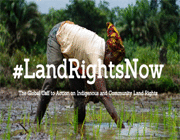
Kapaeeng Foundation (KF) launched Human Rights Report 2016 on Indigenous Peoples in Bangladesh. The launching and dissemination program of the Report was organised on 26 February 2017 at Tawfiq Aziz Khan Seminar Hall of The Daily Star Bhavan in Dhaka. KF published this human rights report with the support of Oxfam.
Former honorable chairman of National Human Rights Commission Prof. Dr. Mizanur Rahman was present as the chief guest while chairperson of Kapaeeng Foundation Mr. Rabindranath Soren presided over the program. Noted women rights activist and Nijera Kori coordinator Khushi Kabir, general secretary of Bangladesh Indigenous Peoples Forum Mr. Sanjeeb Drong and senior policy officer of Oxfam Mehbooba Yasmin were present and delivered their speech.
The program was moderated by Falguni Tripura and vice chairperson of Kapaeeng Foundation Chaitali Tripura delivered welcome speech. Around hundreds human rights defenders, lawyers, academics, journalistsstudents, indigenous rights activists, civil society members, representatives of development partners, among others, were also present and discussants in the event.
Mr. Pallab Chakma, executive director of Kapaeeng Foundation and one of the editor of the report made a presentation on the overall situation of human rights in 2016 on indigenous peoples in Bangladesh.
Prof. Dr. Mizanur Rahman said human rights situation of indigenous peoples is becoming worst day by day. Indigenous peoples in Bangladesh has been unpeopling from the country. State should supposed to taking care of human rights violation of the country. But states fails to protect human rights of indigenous peoples in the country. Human rights violation of a single person threatens human rights of all other peoples in the society. Overall situation of the country will not be improved if violence against indigenous peoples continues.
In the declaration of our independence being said that ensure equality, social justice and human dignity of all people of the country. We called human rights of these three together. But, is state is protecting the dignity of its dignity? he raises the question. The responsibility of the state is protecting the dignity ensure equality and social justice. But we see that police who are responsible to protect the citizens, they are involved in arson of Santal houses in Gaibandha. In this context, he said, Superintendent of Police of Gaibandha district has been transferred to Khagrachari. His job is transferable, then how the transfer is punishment for him? It is the people’s democratic state with a major intellectual fraud. State should bring into justice who is involved with human rights violations, until the end of the investigation should be relieved of his actions and should take appropriate action once the investigation ends.
The former chairman of the National Human Rights Commission also said the state’s sole aim should be to put the welfare of every citizen. And it will be able to make our dreamsBangladesh, Bangabandhu’s golden Bangladesh.
He also said that Bangladesh is becoming middle income country. But the human rights situation in the country does not improve as expected. Without the improvement of the human rights of the people development will not be succeed.Moreover the global human rights is under threat. So all of us have to work together for human rights.
Khushi Kabir said there is no doubt the situation of human rights is not good in our country. People are being killed because of free thought, different culture, language does not welcome here. We must have to improve the situation. The district superintendent of Gaibandha is responsible for human rights violations against Santals is under investigation, how can he transferred to Khagrachari? He urged the government to notify the appropriate logic or reason. Ensuring indigenous rights is state responsibility. Indigenous Identity exist forever if state demolish their identity by calling as “Khudra Nrigoshti.” She said.
Sanjeev Drong said the indigenous peoples of Bangladesh and the situation is going through the worst time ever. The important factor is how many incidents brought into justice instead of decrease or increase numberof human rights violations against indigenous people. He also alleged that not a single case of any incident brought into justice. No single perpetrator got punishment. He also expect that state will take step against all those perpetrators.
Oxfam’s senior policy officer Yasmin Mehbooba said the human rights report on indigenous peoples of the country is helping us understand the true picture of overall situation of human rights. We will able to draw the way forward activity for indigenous peoples through the human rights report.
In his concluding remark Rabindranath Soren said indigenous people had been tortured and forced to migrate to neighboring country due to not getting justice. Therefore, to protect the human rights of indigenous peoples, indigenous peoples have to fight unitedly.
EXECUTIVE SUMMARY OF HUMAN RIGHTS REPORT 2016 ON INDIGENOUS PEOPLES IN BANGLADESH
Indigenous peoples belonging to more than 54 different ethnic groups are known, as per available historical records, to be living across Bangladesh for centuries. 2011 census puts the indigenous population of Bangladesh at around 1,587,000 accounting for 1.08% of the total population of Bangladesh. However, indigenous peoples in the plains strongly dispute the 2011 census report on the figure of their indigenous population and claim that their population in the plains alone is estimated at about 2.0 million. Disaggregated official data being unavailable, the demographic distribution of different ethnic indigenous population groups remained uncertain.
However, they were denied of their recognition as indigenous peoples when 15th amendment to the constitution passed on 30 June 2011 described them as “tribes, minor races, ethnic sects and communities” [Article 23(A)]. Instead they were labelled as “Banglaees” ignoring the distinct identities of indigenous peoples [Article 6(2)]. Bangladesh ratified ILO Convention 107 in 1972, but yet to bring about any positive change in the lives of indigenous peoples. The pledges of the government made in the 7th Five Year Plan to ensure legal protection to indigenous peoples by 1) implementing the UN Declaration on the Rights of Indigenous Peoples 2007 and ratifying the ILO Convention No. 169, 2) formulating a land policy to deal with land disputes involving ethnic communities and finally 3) ensuring the participation of local governments in the management of natural resources” are yet to be materialized.
The Foreign Donation (Voluntary Activities) Regulation Act, passed in October 2016, and the proposed amendments to the Press Council Act are considered by many as instruments to control NGOs freedom of expression and association and for gauging newspapers respectively. On the other hand, a government directive in 2015 requiring individuals of national & foreign organizations to ensure presence of local administration, army/BGB in any events they wish to organize in the CHT, in fact, placed severe restrictions on them.
In the year under review, the indigenous peoples continued to be dispossessed of their lands, the mainstay of their subsistence, as land grabbers’ drive for robbing indigenous peoples’ land using forged land documents, intimidation, gaps in country’s legal system and patronage from the establishment persisted. Legal battle proved futile as there is almost no evidence of restitution of land won in the law court.
Bangladesh claims to have achieved the status of a lower-middle income earning country. However, there is no reflection of this achievement on the lives of indigenous peoples, who still a wait to be lifted out of the cycle of deprivation of rights and marginalization of opportunities. The continuation of the existence of indigenous peoples with their distinctive identities in this country is still threatened. When spaces for accountability, rule of law, democracy and transparency in the country are narrowed down, the miseries of indigenous peoples are destined to be aggravated. However, it is reassuring is that the civil society and media of the country are getting vocal about indigenous peoples’ rights as well as the implementation of the CHT Accord. Despite the presence of a prejudiced section among the mainstream population against indigenous peoples’ aspirations, a number of support-networks among them have started coming up, though their activities are yet to gain necessary momentum.
Situation of Civil and Political Rights
Indigenous peoples need political access to fight for their rights and to hold their governments accountable. The key to stimulating the struggle for human rights of the indigenous peoples lies in their greater political inclusion. Discrimination is widespread in the behavior of public officials both at the national and local level and in the attitude of political parties. The government’s attitude, too, towards indigenous peoples reflects their hegemonic and discriminatory views.
In the last Union Parishad elections held from 11 February 2016 to 4 June 2016 throughout the country, none from among indigenous communities in the plain land could have been elected as chairman, though more than half of indigenous population of the country live there. Unlike in the plain land, chairman candidates from indigenous communities in the CHT won elections in the 83 Union Parishads out of 115 in three hill districts. However, though there is a concentration of indigenous population in the CHT, no single Mayoral candidate from indigenous communities was elected in elections to any of 7 municipalities (pourasavas) in the CHT held in December 2015.
The Supreme Court in one of its rulings restrained law enforcement agencies from making arbitrary arrests on suspicion. However, in spite of the ruling, there is a growing trend of making arbitrary arrests, detention and enforced disappearances in the country and members of law enforcement agencies involved in such crimes enjoy full impunity. In 2016, criminalization of activities of Indigenous Peoples’ Human Rights Defenders (IPHRDs) and IPOs by state and non-state actors continues both in the CHT and in the plains resulting in arbitrary arrests, detention and intimidation of them. In 2016, fabricated cases were filed against at least 191 IPOs and IPHRDs activists including 42 innocent indigenous villagers in the plain land, while 80 activists including 3 public representatives were arrested and more than 81 persons including 4 from the plain land were detained briefly.
In 2016, at least 23 indigenous fellows (including 6 indigenous women and girls, please see ‘Chapter IV: Situation of Women and Girls’ Rights’) were killed in the CHT and in the plains. Despite the rulings against extrajudicial killings by the Supreme Court of the country, quite a number of indigenous peoples were reported to have been extra-judicially killed in 2016. The most ghastly and atrocious incident was the killing of 3 Santals in Gaibandha by police firing.
At least, 96 members of indigenous communities were physically tortured and harassed, and 297 houses including a Buddhist Temple were searched and ransacked by law enforcement agencies while conducting a search operation. At least 3 communal attacks by fanatics, land grabbers and settlers were carried out against indigenous peoples in which their houses and properties were destroyed and looted. As many as 200 houses belonging to indigenous Santals were set on fire and burnt to ashes by land grabbers in presence of the law enforcing agencies and security forces in Gaibandha district in November, 2016. In a video of this incident that went viral in the electronic and social media, police were seen setting fire to the indigenous Santal houses.
The district administration in the CHT were alleged to be indulged in forbidding assemblies and rallies organized by various IPOs. For instances, Khagrachari district administration and law enforcement agencies prohibited, on a number of occasions, formation of human chains organized by IPOs and Civil Society organizations including a 300 kilometre-long in the three hill districts of the CHT on 9 January 2016 demanding for proper, speedy and fullest implementation of the CHT Accord and formation of an independent Land Commission for indigenous peoples of the plain land. This is also disturbing that despite constitutional guarantee in regards to equal status and equal rights in practicing any religious faiths other than Islam, there were alleged reports of religious persecution on indigenous peoples and other religious minorities continues.
Table: Human Rights Violations in 2015 and 2016
| Type of violation | 2015 | 2016 | ||||
| CHT | Plain | Total | CHT | Plain | Total | |
| Arrest and detention | 52 | 22 | 74 | 152 | 9 | 161 |
| Killing | 7 | 3 | 10 | 11 | 6 | 17 |
| Torture, assault and intimidation | 101 | 38 | 139 | 79 | 17 | 96 |
| Communal attack | 4 | 1 | 5 | 2 | 1 | 3 |
| Destruction and looting of house and property | – | 84 | 84 | 97 | – | 97 |
| Houses set on fire | 3 | 32 | 35 | 5 | 200 | 205 |
| No. of persons against whom cases were filed | 128 | 31 | 159 | 149 | 42 | 191 |
Situation of the Rights of Land and Natural Resources
2016 was to become one of the critical years for the indigenous peoples of Bangladesh, especially the Santals of Gobindagonj in Gaibandha district. The local administration with the help of police and hired goons resorted to an eviction drive on 6 November 2016 at Shahebgonj-Bagda Farm area in Gobindagonj to forcibly evict indigenous Santals and poor Bengali farmers from their ancestral land alleging that the lands belonged to the Bagda Farm. This brutal eviction drive left at least 3 Santal men killed and many others injured. Moreover, about 1200 indigenous families were forced to run for their life as their houses were completely burnt to ashes. The incident of Gobindagonj is a glaring example of the extent of helpless that indigenous peoples are thrust in.
Notwithstanding the deep frustration overshadowing the hopes of CHT indigenous peoples, a bold move by the government towards implementing the CHT Accord in 2016 was the amendment of contradictory provisions of the CHT Land Dispute Resolution Commission Act 2001. In spite of many other challenges that still stand in the way of implementing the said law for resolution of land disputes, it is, however, hoped that this amendment would help to resolve land disputes in the CHT and facilitate restitution of dispossessed lands to the rightful owners. On the contrary, in 2016, land confiscation, eviction and attack on indigenous people in the CHT in the name of establishment of tourist spots and BOPs, rubber plantations and land leases to outsiders have alarmingly increased in the CHT. As a whole, the land rights situation remained disconcerting in 2016.
In this year, at least 6 indigenous people were killed, including 5 from the plain land and one from the CHT, and 84 persons were injured in land related incidents in the country. Livelihoods of at least 31699 families of which 606 families were from the CHT and 31093 families from the plains came under threat following persistent land grabbing belonging to indigenous peoples. Besides, 1208 houses of indigenous peoples were burnt to ashes in the plain land.
Moreover, over 15429.98 acres of lands belonging to indigenous peoples were reported to have been brought under the process of acquisition, mostly for the establishment of special economic zone, special tourist zone and reserve forests. Land grabbing in the plains led to the eviction of 1216 families from their homesteads and 1035 families were being threatened with eviction both in the CHT and in the plain land. Moreover, this year, at least 17 houses belonging to indigenous peoples were destroyed and looted while 37 women were molested by land grabbers in the land related incidents both in the CHT and in the plains. Unfortunately, most of the wrongdoers remained unpunished.
Compared to 2015, the number of houses burnt, persons assaulted and injured, families evicted, women molested and the number of persons killed increased noticeably in 2016. The number of families threatened with eviction remained almost the same compared to the previous year. But the premeditated brutalities committed in Gobindagonj in November, at the end of the year, had out did the magnitude of fatalities in the plains triggered during the previous year.
Table: Land Related incidents and causalities in 2016
| Form of atrocity | CHT | Plains | Total |
| No. of Houses burnt to ashes | 1208 | 1208 | |
| No. of houses looted and ransacked/ demolished | 7 | 10 | 17 |
| No. of persons assaulted & injured | 2 | 82 | 84 |
| No. of person killed | 1 | 5 | 6 |
| No. of rape attempts/ molestation against women | 8 | 29 | 37 |
| No. of families livelihood under threaten | 606 | 31093 | 31699 |
| No. of evicted families | 1216 | 1216 | |
| No. of families threaten to evict | 31 | 1004 | 1035 |
| Amount of land under grabbing/acquisition (in acres) | 2333.98 | 13096 | 15429.98 |
| No. of persons against whom false case filled | 58 | 400 | 458 |
| Arrest | 9 | 4 | 13 |
| No. of religious institution/graveyard are in danger of land grabbing | 1 | 4 | 5 |
Situation of the Rights of Indigenous Women and Girls
As many as 53 cases of violence against indigenous women were reported from January 2016 to December 2016 in which a total of 58 indigenous women and girls were assaulted sexually and physically. 25 of these cases took place in the plain lands in which 28 indigenous women and girls were victims of physical and sexual violence in contrast to 28 such cases in the CHT where 30 women and girls were the number of victim/survivor.
As of December 2016, rape attempts were made on at least 10 indigenous women and girls. Besides, 8 indigenous women were physically assaulted, 17 women were raped, six were killed/ killed after rape, nine women were gang raped. Furthermore, 2 cases on sexual harassment and 5 kidnapping cases were reported. Among the 85 offenders, 72 were from the mainstream Bengali community and two happened to be a member of law enforcement agency, while 11 malefactors were from the indigenous background. The age of the victims were reported to be ranging from 3 to 35 years.
The figures of human rights violations against indigenous women and girls as reported in 2016 dropped slightly in relation to what happened in 2015. For instance, in 2015 the total number of cases on human rights violations against indigenous women from January to December was 69 while the number stood at 85. In the next previous year during the same time period, a total of 53 incidents have occurred in which 58 indigenous women and girls fell victims of physical and sexual violence. The causes for such a fall in incidents of violence against the female members of indigenous communities may be traced either to the development of some positivity, especially on human rights issues of indigenous people, in the attitude of a section of the mainstream population or may be the beginning of change in the outlooks and perspectives of mainstream people towards indigenous women.
Table: Types of Violence against Indigenous Women and Girls and Number of these Victims/Survivors of Violence in Bangladesh (2007-16)
| Year | Rape/Gang Rape | Killed after Rape | Physical Assault | Attempted Rape | Abduction/Kidnap | Sexual Harassment /Molested | Trafficking | Total |
| 2007 | 5 | – | – | 3 | 1 | – | 9 | |
| 2008 | 3 | 1 | – | – | – | – | 4 | |
| 2009 | 2 | 4 | 6 | 3 | 1 | – | 16 | |
| 2010 | 7 | 5 | 6 | 5 | 2 | – | 25 | |
| 2011 | 11 | 7 | – | 8 | 5 | – | 31 | |
| 2012 | 17 | 7 | 36 | 13 | 2 | – | 75 | |
| 2013 | 15 | 4 | 16 | 9 | 5 | 10 | 8 | 67 |
| 2014 | 21 | 7 | 58 | 22 | 10 | 4 | 0 | 122 |
| 2015 | 28 | 3 | 21 | 17 | 5 | 9 | 2 | 85 |
| 2016 | 26 | 6 | 8 | 10 | 6 | 2 | 0 | 58 |
| Total | 135 | 44 | 151 | 90 | 37 | 25 | 10 | 492 |
Human Rights Organisation “Odhikar” reported that there were 1028 women victims of which 757 were raped and 271 were sexual harassed in 2016. If compared in terms of percentage by assuming all the 1028 victims as Bengali and indigenous women and girls, we find that 5.7% of the victims/survivors in 2016 were from indigenous communities, who are merely 1.8% of country’s total population, while the remaining 94.3% victims were from the Bengali community, who are the majority in the country with 98.2% of the total population. This statistical data makes it clear that the propensity of sexual crime and physical violence against indigenous women is higher than that faced by mainstream Bengali women. Such incidents occur massively due to ethnic and cultural differences.
A glance at the numbers and incidents of human rights violations against indigenous women and girls makes it clear that similar to the previous years, indigenous women in the plains were at a higher risk of being targets of violence in 2016 compared to indigenous women in the CHT. There are also other forms of violence (such as emotional violence, cybercrimes against indigenous women and girls, domestic violence etc.) which remain unreported or if not, less reported. In addition, the mortality rate among indigenous women is high due to poor existing maternal health services or absence/lack of proficient gynecologists indicating inadequate health care services and lack of health professionals to address the concern.
State of Child, Youth and Education Rights
While the human rights situation of indigenous peoples in general is in a dreadful state, a closer look into the state of human rights of indigenous children and youths in the country also doesn’t reveal a satisfactory picture. The issues of indigenous children often take the backseat and not much of it is discussed about. There is the lack of segregated data and information on indigenous children issues. Accordingly, it is problematic to analyse the human rights situation of indigenous children in the country. However, from a routine observation it becomes clear that indigenous children in Bangladesh are doubly discriminated — firstly, because they are indigenous and secondly, because they are children. Their human rights enshrined in the Convention on the Rights of the Child (CRC), to which Bangladesh is a signatory, are routinely violated. Article 30 of the CRC directs the States to take measures so that any indigenous child “shall not be denied the right, in community with other members of his or her group, to enjoy his or her own culture, to profess and practice his or her own religion, or to use his or her own language.” While the rights to culture, religion and language enshrined in this article are deemed imperative, indigenous children are often seen to be denied of and discriminated against on the ground of these issues.
Similar to that of children, indigenous youth too face age-group-specific human rights issues because of their identity firstly as indigenous and secondly as youth. Indigenous youths, being always in the forefront of handling issues affecting indigenous communities as a whole, often confront a situation that tend to curb their rights seriously. Especially, when it comes to violations of human rights faced by indigenous peoples, youths tend to be the prime victims. As was shown in other chapters of the report, indigenous youths, including girls (covered with special attention in Chapter IV), is one of the groups among indigenous peoples that faced discrimination and rights violations most in 2016.
Amid mixed developments in different areas of rights of indigenous children and youths, their right to education remained in the focus throughout the year. Government repeatedly expressed its commitment to bring changes in this regard. Government representatives on many occasions uttered about introducing mother tongue based pre-primary education in five indigenous languages and undertaking of other related initiatives as well. Thus, although such positive developments were observed throughout the year, some initiatives put into action by the government violated the educational rights of children and youths instead and suffered as well from serious limitations.
CHT Accord of 1997: Present State and Challenges of Its Implementation
After holding decade-long dialogues with the successive governments from 1985 to 1997, the CHT Accord was signed on 2 December 1997 with an aim to resolve CHT crisis through political and peaceful means. But substantial progress is yet to be achieved due to non-implementation of the main issues of the Accord.
The Government implemented some provisions of the Accord, such as, enactment of CHT Regional Council Act 1998, amendment of three Hill District Council Acts in 1998 and enactment of CHT Land Dispute Resolution Commission Act 2001 which was amended in 2016 as per 13-point recommendations; formation of interim CHTRC and Ministry of CHT Affairs; repatriation of Jumma refugees from Indian state of Tripura; withdrawal of around 100 temporary camps (where the government claims withdrawal of around 200 camps); formation of CHT Accord Implementation Committee, CHT Land Dispute Resolution Commission and Task Force on Rehabilitation of Returnee Refugees and IDPs, etc.
However, no effective initiative for implementation of the main issues of the Accord has been taken even after 19 years. The main issues remain unimplemented are legal and effective safeguard measures to preserve tribal-inhabited features of the region, devolution of powers and functions to the CHTRC and three HDCs, holding elections of the CHTRC and three HDCs formulating Electoral Roll Rules and Election Rules and preparing voter list with permanent residents of three hill districts of CHT, withdrawal of all temporary camps and de facto military rule ‘Operation Uttoron’ (Operation Upliftment) from CHT, with a time limit to be announced immediately, rehabilitation of Internally Jumma Displaced Families and Returnee (India-Returned) Jumma Refugees and returning lands and homesteads back to them, amendment of all the other laws applicable to CHT including the Police Act, Police Regulation and CHT Regulation 1900 to make them in conformity with the Accord.
At last, in August 2016 the contradictory clauses of the CHT Land Dispute Resolution Commission Act 2001 have been amended after long delay and negotiation.Although the CHT Land Commission has started to function, the effective functioning of the Commission in settling land disputes is still questionable due to the constraints as a result of limited initiatives by the government. The office setup is very poor with limited resources including fund, logistic and human resources. After transfer of secretary of the Land Commission from the office of the Commission in November 2016, it has only two staff. Even, the Commission does not have any fund for functioning of day-to-day works. The government is yet to allocate adequate fund, to approve adequate manpower and to set up two sub-office in Rangamati and Bandarban district. The Rules of Business of the Commission is yet to be framed. The CHTRC submitted a draft Rules of Business to the government in December 2016, but no substantial progress has been found in finalising and approving the draft Rules of Business. Without having Rules of Business, it would be difficult for the Commission to start hearing of the land disputes as well as judicial functions of the Commission.
It is to be mentioned that different decisions are being taken and implemented with regard to matters relating to general administration, law & order, and development by the government authorities, without consulting or informing the CHT Regional Council and Hill District Councils. For instance, in forming and setting up of Guimara upazila, Sajek police station, and Bartholi union, the CHT Regional Council and the concerned Hill District Council were not consulted before deciding on such important issues. Decisions on development activities of public interests such as construction of border roads along the three hill districts, land port at Thegamukh, setting up of luxurious tourism complexes under the patronage of local military authority and Parjatan Corporation, declaration of protected and reserved forests, installation of Border Out Posts (BOP) for Border Guard Bangladesh (BGB) are being made and implemented without consulting with the CHT Regional Council and the three Hill District Councils.
Since reconstitution of the Task Force during the present grand alliance government (2009-2016), no development in rehabilitating the internally displaced Jumma families, returnee Jumma refugees and ex-combatants of PCJSS has been achieved. The government side is still following the previous policy to rehabilitate Bengali settlers in the CHT identifying them as IDPs which is contradictory to the CHT Accord. As a result, though 19 years have passed by after signing the CHT Accord, the rehabilitation process of the tribal IDPs remains in the dead end situation.
Please click here to download the Human Rights Report 2016
Published on 26 February 2017.



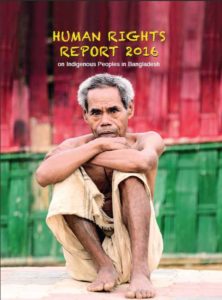
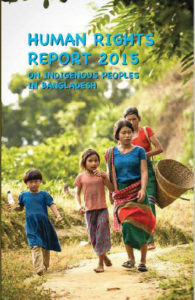
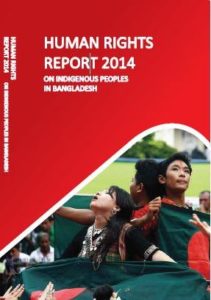
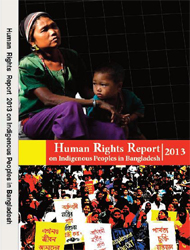
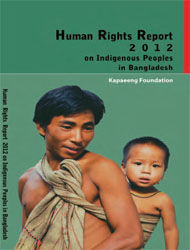
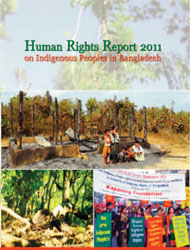
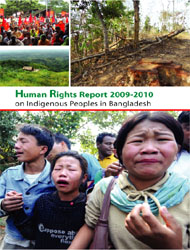

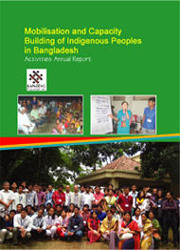



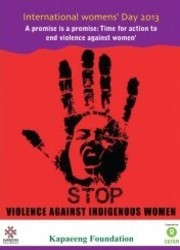

 February 26th, 2017
February 26th, 2017  KapaeengUser
KapaeengUser  Posted in
Posted in  Tags:
Tags: 